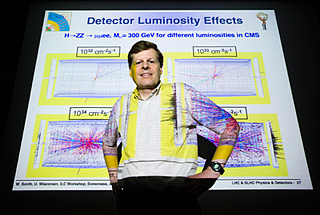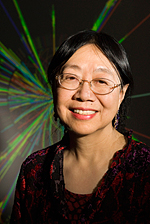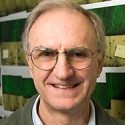Giant collider back in gear, sets record for collision intensity
On Nov. 30, the world’s largest scientific instrument, the Large Hadron Collider, set a record when it smashed one stream of protons against another and then accelerated the beams to 1.18 trillion electron volts, exceeding the record held by Fermilab in Illinois since 2001.

UW-Madison physics professor Wesley Smith heads a team that designed and built a major portion of the Compact Muon Solenoid — a giant particle detector built around a super-strong magnet. “You identify all the particles coming out, you identify all their energies, then add everything back up, and you have the complete picture of what happened in the collision,” says Smith. It’s a big job: The collider is expected to produce up to 600 million collisions per second.
Photo: Jeff Miller
Related story: Heart of the Matter, published in the Fall 2008 issue of On Wisconsin.
The restart is welcome news to a large team of physics professors, scientists and students at UW–Madison, who have been developing the collider’s technology and are ready to start a broad range of scientific experiments. “It’s a very exciting time,” says professor of physics Wesley Smith, who has been developing one of four mammoth particle detectors. “Although the first beams operated at low energy, they are teaching us a lot about the detector and its performance. It’s thrilling, after 15 years of effort, to see data coming from what was once just a design.”
“Everyone is very excited,” says Sau Lan Wu, a professor of physics who works on a detector called ATLAS. “We find that the ATLAS detector is checking out very well. Recently, our group met for six hours, and everybody was showing what they learned.”
Although the data contained nothing new, the success was welcome, coming as it did more than a year after an electrical malfunction derailed the collider’s initial startup. Experts are now gaining confidence that the long, expensive project will start producing scientific results in the winter.

UW-Madison physics professor Sau Lan Wu leads a group that helped develop ATLAS, one of the two main particle detectors at the Large Hadron Collider. Her quarry, the Higgs boson, is thought to explain why matter has mass.
Photo: Jeff Miller
The collider, operated by CERN, the European Organization for Nuclear Research, spans the French-Swiss border and has become the world center for particle physics. The giant machine’s fundamental goal is to understand the physical world at the most basic level, and it could illuminate such subjects as multiple universes, dark matter and dark energy.
Smith says that when the collider’s 16-mile ring is operating at full strength of 7 trillion electron volts, each proton will carry as much energy as it would gain from passage through 1.17 trillion car batteries.
The collider is supposed to re-create the conditions found one billionth of a second after the big bang kick-started the universe 13.7 billion years ago.
Smith’s UW–Madison group helped design, install and test one of the four collider detectors, called the Compact Muon Solenoid, a 12,000-ton apparatus located 300 feet underground.
Inside each detector, the streams of protons are channeled into collisions that release stream of particles that will almost instantly be “seen” by tens of millions of individual detection elements. “When particles enter the detector, they better hit these elements in time,” Smith says. “It’s like being an orchestra conductor who is trying to conduct everything to within a few nanoseconds.”
Wu works on the ATLAS detector, which is 144 feet long and 72 feet high. ATLAS, the largest of the collider’s four detectors, registers data on about 100 million channels simultaneously. Part of her long effort on the collider has gone to developing software that will save interesting collisions for analysis and ignore almost all of the torrent of incoming data. Otherwise, the detector could fill 100,000 CDs per second.
Working with associate professor of physics Yibin Pan and assistant professor of physics Bruce Mellado, Wu is on the hunt for an elusive particle called the Higgs boson. “This is a missing link in the standard model of physics, which has been very successful in describing most of high energy physics,” she says.
In the standard model, the Higgs boson is introduced to explain why particles have mass. “We are still looking for this particle; the fact that you weigh so many pounds is due to the Higgs boson, which is the only piece of the standard model that remains to be found,” says Wu. “I have been preparing to look for Higgs since 1983. Some people think that it is more interesting if it is not found, but I disagree. I am confident that it will be found at the Large Hadron Collider.”
Smith, for his part, says physics wins either way. “In the unlikely case that we don’t find the Higgs, the basis of our understanding would be wrong, and we would learn a lot.”

